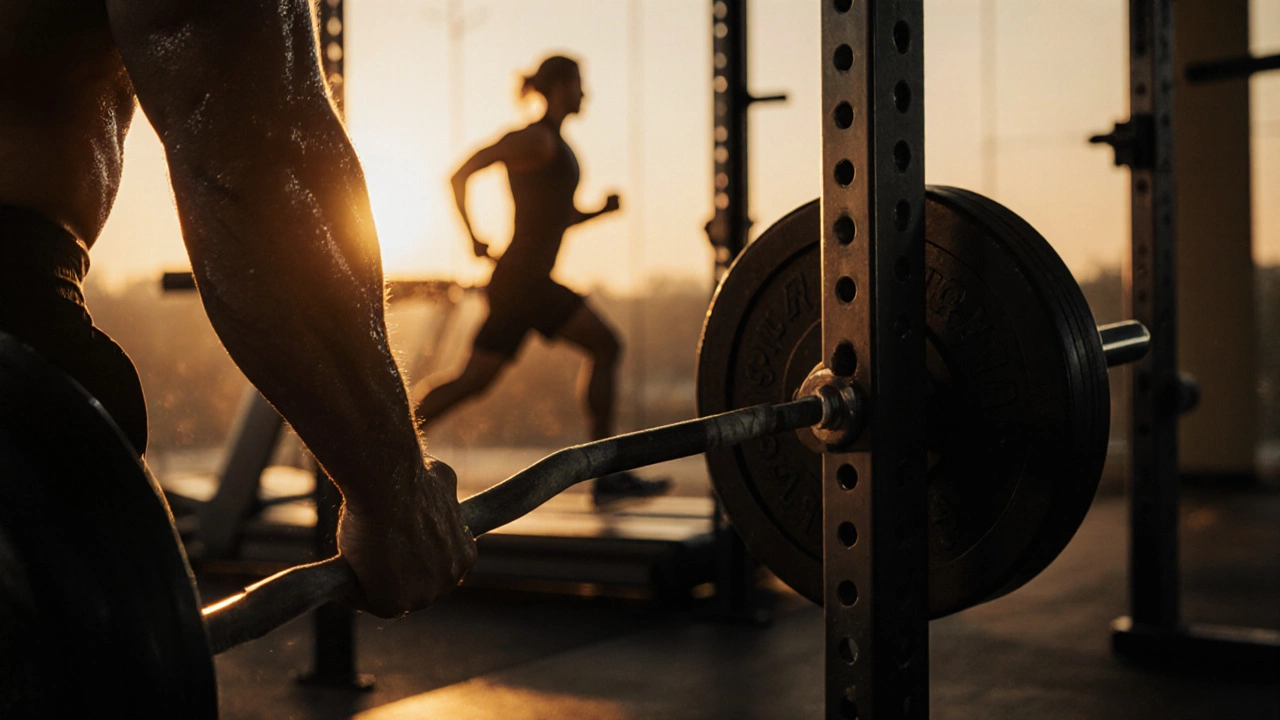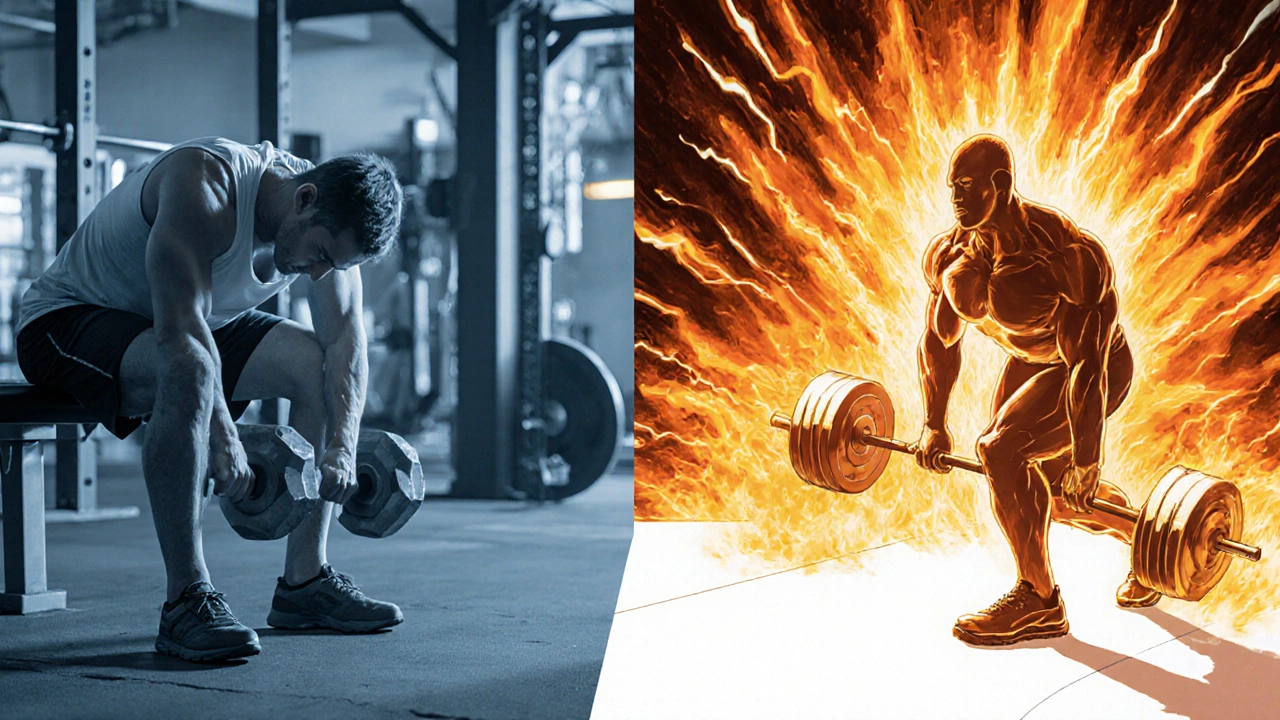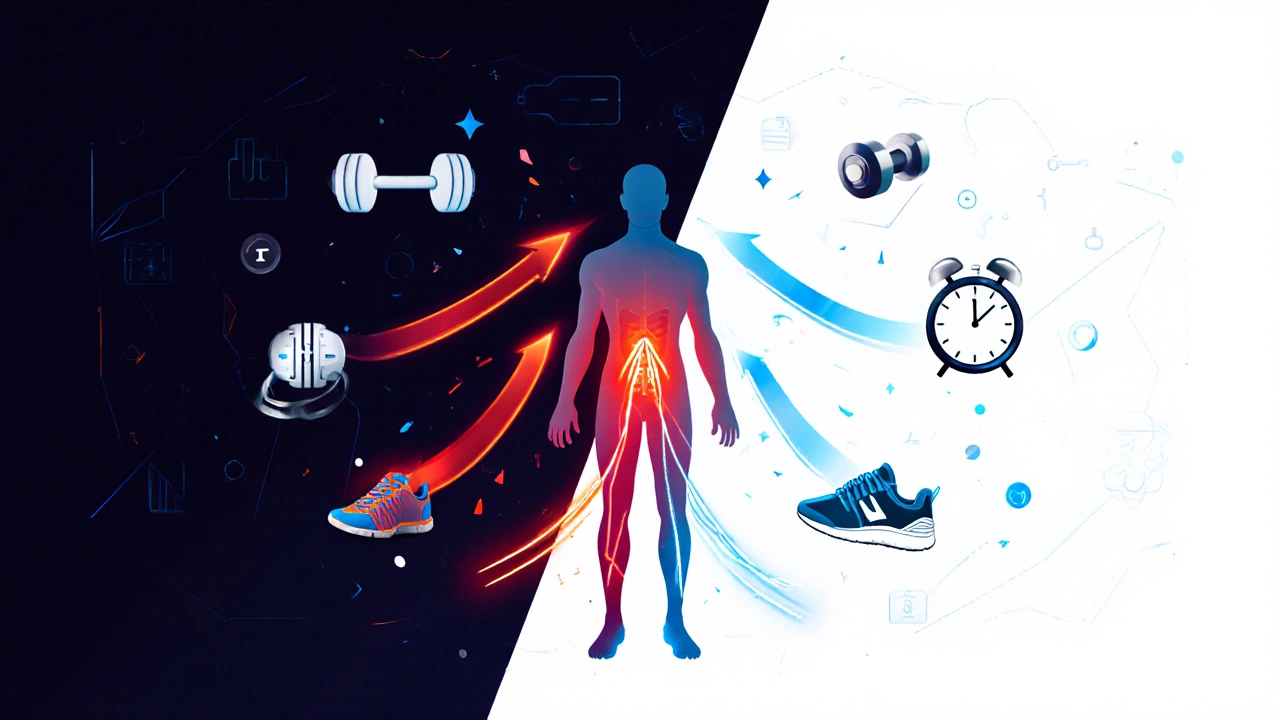
Workout Order Calculator
Which is your main goal?
Select your primary fitness objective to get personalized recommendations
How much time do you have?
Select your workout duration to get appropriate recommendations
Your energy level?
Select how you're feeling today
Ever walked into the gym, stared at the treadmill and the dumbbells, and just… frozen? You know you need both cardio and strength training. But which one should you do first? It’s not just about preference-it’s about what actually works for your body, your goals, and your energy levels.
Why the Order Matters
Doing cardio before weights isn’t just a habit-it’s a choice that changes how your muscles perform. When you run, cycle, or row for 30 minutes before lifting, you’re already draining your glycogen stores. That’s the fuel your muscles use for heavy lifting. By the time you get to the bench press or squats, your legs might feel like lead. Your form suffers. You can’t lift as heavy. You don’t stimulate muscle growth as effectively.
On the flip side, if you lift first, you’re fresh. Your central nervous system is fired up. Your muscles are fully charged. You can push harder, lift heavier, and get more out of your strength session. That’s critical if your main goal is building muscle or getting stronger.
A 2018 study from the Journal of Strength and Conditioning Research found that subjects who lifted weights before doing cardio improved their strength gains by 18% compared to those who did cardio first. The difference wasn’t small. It was measurable, repeatable, and tied directly to energy availability.
What If Your Goal Is Fat Loss?
Here’s where people get confused. If you want to burn fat, shouldn’t you do cardio first to tap into fat stores? Not necessarily.
Yes, cardio burns calories. But here’s the catch: the most effective fat loss comes from preserving muscle while burning fat. Muscle is metabolically active. The more you have, the more calories you burn at rest. If you exhaust yourself with cardio first, you’ll lift lighter, build less muscle, and slow down your metabolism over time.
Instead, do this: lift weights with full intensity. That builds muscle. Then do 15-20 minutes of moderate cardio. You’ll still burn fat-just more efficiently. Your body will use leftover glycogen during cardio, then start tapping into fat stores once that’s depleted. You get the muscle-preserving benefit of strength training, plus the calorie burn of cardio.
One real-world example: a 38-year-old woman in Auckland tracked her body composition for six months. She lifted first, then did 20 minutes of brisk walking on the treadmill. She lost 7% body fat and gained 2.3 kg of lean muscle. Her friend, who did cardio first, lost 5% body fat but also lost 0.8 kg of muscle. The difference? Order.
What About Endurance Athletes?
If you’re training for a marathon, triathlon, or cycling race, your body needs to adapt to endurance. In that case, doing cardio first makes sense-especially on long training days.
But even then, it’s not about doing cardio every single day before weights. Most endurance athletes do strength training 2-3 times a week, not daily. On those days, they often do strength after a short warm-up cardio session (10 minutes max) to get blood flowing. The heavy lifting comes after the warm-up, not after a 45-minute run.
Elite runners don’t do 10K before squats. They do light dynamic mobility, then strength work focused on stability and power-like single-leg deadlifts, box jumps, and core work. Then they run. The goal isn’t to exhaust themselves. It’s to enhance performance.

When You Should Do Cardio First
There are a few real situations where cardio before weights is the smarter move:
- You’re doing a dedicated cardio day. If your plan is to run 10K or ride 50K, don’t waste energy lifting. Save strength for recovery days or separate sessions.
- You’re training for a sport where endurance is priority. Think soccer players, rowers, or cross-country skiers. Their sport demands stamina, so they prioritize aerobic conditioning.
- You’re recovering from injury or illness. If your energy is low, start with light cardio to warm up gently before easing into strength work.
- You’re short on time and want maximum calorie burn. If you only have 30 minutes, do 20 minutes of cardio and 10 minutes of bodyweight strength. It’s not ideal for muscle growth, but it’s better than nothing.
What About HIIT?
HIIT is its own beast. High-intensity interval training blends cardio and strength in bursts. If you’re doing a HIIT workout that includes kettlebell swings, burpees, and sprints, you’re already doing both at once.
In that case, don’t add extra cardio or weights afterward. You’re already pushing your system to its limit. More isn’t better-it’s riskier. Overtraining leads to injury, burnout, and stalled progress.
Instead, treat HIIT as your main workout. Do it 2-3 times a week. On other days, focus on steady-state cardio or strength training separately. That way, you recover properly and keep improving.
How to Structure Your Week
Here’s a simple, realistic weekly plan that works for most people:
- Monday: Strength training (full body) - weights first, then 15 min cardio
- Tuesday: Steady-state cardio (brisk walk, bike, swim) - 45 minutes
- Wednesday: Rest or light mobility/yoga
- Thursday: Strength training (upper body) - weights first, then 15 min cardio
- Friday: HIIT - 20 minutes, no extra cardio or weights
- Saturday: Active recovery (hike, light bike ride)
- Sunday: Strength training (lower body) - weights first, then 15 min cardio
This structure gives you 3 strength sessions, 2 cardio sessions, 1 HIIT, and 2 rest/recovery days. It balances intensity and recovery. It’s sustainable. It works.

Listen to Your Body
Rules are helpful, but your body talks. If you’re exhausted, sleep-deprived, or stressed, forcing a hard workout first thing might backfire. Sometimes, a light 20-minute walk before lifting helps you feel more alert. Other days, you need to lift heavy while you still have energy.
Track how you feel. Ask yourself after each workout: Did I get stronger? Did I hit my reps? Did I feel energized or drained? That’s your real feedback loop-not someone’s Instagram post.
The Bottom Line
If your goal is strength, muscle growth, or body recomposition: do weights first. Save cardio for after, or on separate days.
If your goal is endurance: do cardio first on long training days, but keep strength sessions focused and short.
If you’re just trying to stay healthy and burn fat: lift weights first, then do moderate cardio. You’ll lose fat and keep muscle.
There’s no universal rule that fits everyone. But there is a science-backed default: strength before cardio. It’s the most effective starting point for most people. Adjust from there based on your goals, energy, and schedule.
Should I do cardio before weights if I want to lose weight?
Not necessarily. Doing cardio first may burn more calories during the workout, but it can reduce your strength performance, leading to less muscle gain. Muscle burns more calories at rest, so preserving or building it helps long-term fat loss. Do weights first, then 15-20 minutes of cardio for the best balance.
Can I do cardio and weights on the same day?
Yes, and it’s often ideal. Just make sure you prioritize based on your main goal. If strength is your focus, lift first. If endurance is your focus, do cardio first. Keep sessions under 90 minutes total to avoid overtraining.
Is it bad to do cardio after weights?
No, it’s actually better for most people. After lifting, your muscles are fatigued, but your heart and lungs are ready for steady work. Light to moderate cardio afterward helps clear lactic acid, improves circulation, and aids recovery without interfering with muscle growth.
What if I only have 30 minutes to work out?
Do 20 minutes of strength training using compound moves like squats, push-ups, and rows. Then do 10 minutes of high-intensity intervals-like jumping jacks, mountain climbers, or kettlebell swings. This combo builds muscle and burns fat efficiently in minimal time.
Does doing cardio first help burn more fat during the workout?
Yes, your body may use more fat as fuel during cardio if done on an empty stomach or after a long fast. But the total fat burned over 24 hours is similar whether you do cardio first or last. The bigger factor is preserving muscle-which happens when you lift first.
Next Steps
Try this for two weeks: always lift weights before cardio. Track your lifts-how much weight you used, how many reps you completed. Then track how you feel during cardio afterward. Do you have more energy? Can you go longer? Are you less sore the next day?
Compare it to your old routine. You might be surprised. Most people find they lift heavier, recover faster, and feel more energized overall when they prioritize strength.
Remember: consistency beats perfection. Do what works for your schedule, your energy, and your goals. But if you’re unsure where to start, go with the science: weights first.
